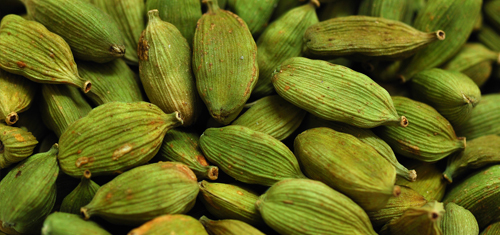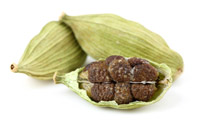Cardamom
Cardamom
Pronounced: KAR-duh-muhm

Cardamom is an ancient spice, existing in India more than a thousand years before the birth of Christ. It is the third most expensive spice, after saffron and vanilla. The spice reached Europe along the caravan routes. Ancient Greece and Rome valued cardamom as an ingredient in perfumes, as well as breath fresheners and digestive aids.
Cardamom is well known as a spice and is one of the primary constituents of Garam Masala. Cardamom is a spice native to the Middle East, North Africa, and Scandinavia. It is best to buy cardamom still in the pods, which are removed and discarded. You can also buy cardamom seeds however; they lose much of their flavor. Ground cardamom has even less flavor than the fresher ones. Most recipes usually call for green cardamom. Cardamom has a strong, unique spicy-sweet taste, which is slightly aromatic. Cardamom is considered one of the most valuable spices in the world due to its rich aroma and therapeutic properties.
What Is Cardamom?
 Cardamom is selected queen of spices for royals. Cardamom derives its name from a Latin word and in India it is popularly known as “Elaichi”. It is a member of the ginger family known as Zingiberaceae. Cardamom can be identified by small, spindle shaped seed pod which is triangular in the cross section. The seed pod has a thin papery shell which carries small black seeds.
Cardamom is selected queen of spices for royals. Cardamom derives its name from a Latin word and in India it is popularly known as “Elaichi”. It is a member of the ginger family known as Zingiberaceae. Cardamom can be identified by small, spindle shaped seed pod which is triangular in the cross section. The seed pod has a thin papery shell which carries small black seeds.
Cardamoms satisfy the four main purposes i.e. food, drink, medicines & perfumes through taste, flavor, cure & fragrance respectively. It is widely used as a herbal spice and is added in various sweet dishes to provide a strong aroma & flavor. In Ayurveda it is considered to be a very useful & effective medicine.
Plant and Cultivation
Green cardamom pods come from a perennial bush of the ginger family that can grow to up to 12 feet tall. It is native to India, and grows wild in rainforests of southern India and Sri Lanka, at relatively low altitudes. The plant will only flower and fruit in tropical climates. Guatemala is now the largest exporter of cardamom, even more so than India. The plant needs wet soil and heat to grow and bear the little fruits, harvested just before fully ripe and dried, either in the sun, similarly to coffee, or in special drying rooms. The very best dried cardamom pods are pale greenish in color. Each paperlike pod holds approximately 12 to 20 dark brown or black highly aromatic seeds. Cardamom is relatively expensive due to the harvesting process. The plants attain maturity in about 20-22 months. Economic production starts from 3rd year onwards and it continues up to 8-12 years with good management practices.
Over several months the pods are individually picked just before they are about to mature to ensure they don’t split or lose their color. It is the oil-laden seeds of the cardamom pods which define the flavor. It is best to buy either whole pods or whole seeds that have been removed from the pod. Pre ground cardamom loses its flavor too easily
Description
Cardamom spice is a variety of two species’, Elettaria cardamomum, or Amomun kravanb. The cardamom plants can grow to be large bushes consisting of long, straight, slender stems with numerous symmetrical, dark green, pointed leaves.The cardamom plant has a thick, fleshy root called a rhizome, or an underground stem from which shoots emerge. Cardamom produces beautiful little, lightly colored flowers that appear most of the year and produce the green cardamom fruits. These green pods are picked before reaching maturity and usually contain approximately 12 cardamom seeds.Look for cardamom pods with more of a green (lime-like) color than pods that are a green brown, which is often a sign of age. The pods should have a pungent aroma. If they are split open many of the volatile oils will have been lost. The seeds, once removed, will lose their flavor more rapidly. It is recommended that you buy the best quality pods and remove the seeds as you need to use them.
Producing Countries of Cardamom
Cardamom is generally produced in the tropical regions of the world. Major producing countries of cardamom in the world are Guatemala, India, Srilanka, Iran, Tanzania etc. However, major production is concentrated in Guatemala and India. Although there are no official estimates available, world cardamom production is estimated to be over 55000 MT. Of the total, Guatemala accounts for nearly30000 MT following by India with about 15000-18000 MT annually.
Consuming Countries of Cardamom
Consumption of cardamom has sharply increased throughout the world during the last two decades. The major consuming countries of cardamom are the Middle Eastern countries, India, Pakistan, European countries, the US, and Japan. Middle Eastern countries such as Saudi Arabia and the United Arab Emirates, and South-East Asian countries such as India, etc., account for more than 60% of the world’s consumption. Saudi Arabia is the single largest importer of Cardamom in the world, followed by Kuwait. The list of countries / territories that are the major importers is as follows: Saudi Arabia ,Kuwait ,UAE ,USA ,Japan ,Pakistan ,U.K ,Malaysia ,Israel ,Australia ,Canada and South Africa.
